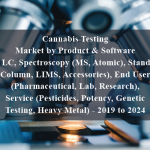OVERVIEW
The Transfection Reagents and Equipment Market is currently valued at USD 1.19 billion in 2024 and will be growing at a CAGR of 6.18 % over the forecast period to reach an estimated USD 1.6 billion in revenue in 2029. The transfection reagents and equipment market encompasses a diverse array of tools and technologies crucial for introducing foreign genetic material into cells for various research, therapeutic, and biotechnological applications. This market includes a wide range of reagents such as lipids, polymers, and calcium phosphate, alongside specialized equipment like electroporation devices, microinjectors, and gene guns. These tools facilitate the delivery of nucleic acids, proteins, and other molecules into cells with precision and efficiency, enabling researchers to manipulate gene expression, study cellular processes, and develop novel therapeutics. With the increasing demand for advanced genetic engineering techniques in fields like biopharmaceuticals, gene therapy, and synthetic biology, the transfection reagents and equipment market continues to expand, driven by innovation, technological advancements, and growing investments in life sciences research.
The expanding scope of biomedical research and drug development, particularly in areas like gene therapy, stem cell research, and cancer immunotherapy, is fostering a demand for advanced transfection technologies. Additionally, the increasing prevalence of genetic disorders and chronic diseases is fueling the need for innovative therapeutic interventions, thereby driving the adoption of transfection reagents and equipment for gene editing and delivery. Moreover, the growing investments in biotechnology and pharmaceutical industries, coupled with supportive government initiatives and funding for genetic research, are further boosting market growth. Furthermore, advancements in transfection technologies, such as the development of novel delivery vectors, improved transfection efficiency, and reduced cytotoxicity, are enhancing the attractiveness of these tools for a wide range of applications. Lastly, the rising trend of personalized medicine and the pursuit of precision healthcare are expected to drive the demand for tailored gene therapies and targeted drug delivery systems, thereby stimulating the growth of the transfection reagents and equipment market.
Market Dynamics
Drivers:
The expanding scope of biomedical research and drug development, particularly in areas like gene therapy, stem cell research, and cancer immunotherapy, is fostering a demand for advanced transfection technologies. Additionally, the increasing prevalence of genetic disorders and chronic diseases is fueling the need for innovative therapeutic interventions, thereby driving the adoption of transfection reagents and equipment for gene editing and delivery. Moreover, the growing investments in biotechnology and pharmaceutical industries, coupled with supportive government initiatives and funding for genetic research, are further boosting market growth. Furthermore, advancements in transfection technologies, such as the development of novel delivery vectors, improved transfection efficiency, and reduced cytotoxicity, are enhancing the attractiveness of these tools for a wide range of applications. Lastly, the rising trend of personalized medicine and the pursuit of precision healthcare are expected to drive the demand for tailored gene therapies and targeted drug delivery systems, thereby stimulating the growth of the transfection reagents and equipment market.
Key Opportunities :
The transfection reagents and equipment market presents several key opportunities for growth and innovation. One significant opportunity lies in the advancement of delivery systems that can overcome existing limitations, such as low transfection efficiency and cytotoxicity, thereby expanding the applicability of transfection technologies in both research and therapeutic settings. Additionally, the increasing adoption of CRISPR-based gene editing techniques is creating a demand for specialized transfection reagents and equipment optimized for delivering CRISPR components into target cells with high precision and efficacy. Furthermore, the emergence of novel applications, including cell-based therapies, regenerative medicine, and genome editing for agricultural biotechnology, opens up new avenues for market expansion. Moreover, the integration of transfection technologies with emerging fields such as nanotechnology and microfluidics presents opportunities for developing innovative platforms for precise and efficient delivery of biomolecules into cells. Finally, the growing emphasis on automation and scalability in bioprocessing and drug manufacturing creates opportunities for the development of high-throughput transfection systems capable of meeting the demands of large-scale production, thereby addressing the needs of the biopharmaceutical industry.
Restraints :
One significant challenge is the potential for off-target effects and unintended genomic alterations associated with certain transfection methods, particularly those involving viral vectors or CRISPR-based gene editing tools. These safety concerns pose regulatory hurdles and may hinder the adoption of transfection technologies in clinical applications. Additionally, the high cost of advanced transfection reagents and equipment, coupled with the need for specialized expertise to optimize experimental protocols, limits accessibility, particularly for smaller research laboratories and academic institutions with limited budgets. Moreover, variability in transfection efficiency and reproducibility across different cell types and experimental conditions presents a technical challenge, leading to inconsistencies in experimental results and hindering the reliability of research findings. Furthermore, ethical considerations surrounding gene editing and genetic manipulation raise societal concerns and may impact public acceptance and funding for related research initiatives. Finally, the complexity of transfection protocols and the time-consuming nature of optimization procedures can impede workflow efficiency and productivity, especially in high-throughput screening and drug discovery applications, thereby posing practical challenges for researchers and biopharmaceutical companies alike. Addressing these restraints will require continued innovation, collaboration, and regulatory oversight to ensure the safe and effective use of transfection technologies in research and clinical settings.
Regional Information:
• In North America, the transfection reagents and equipment market is characterized by robust research and development activities, driven by well-established biotechnology and pharmaceutical industries, along with significant government funding for life sciences research. The presence of key market players and academic institutions at the forefront of genetic engineering and biotechnology innovation further accelerates market growth. Additionally, favorable regulatory policies and a strong emphasis on translational research contribute to the widespread adoption of advanced transfection technologies in both academic and industrial settings.
• In Europe, the transfection reagents and equipment market benefits from a highly collaborative research ecosystem, supported by renowned academic institutions and government initiatives promoting biotechnology innovation. The region boasts a strong biopharmaceutical industry and a growing emphasis on personalized medicine, driving demand for transfection technologies in gene therapy, cell-based therapies, and regenerative medicine. Moreover, stringent regulatory standards ensure the safety and quality of transfection products, fostering consumer confidence and market growth.
• In the Asia Pacific region, the transfection reagents and equipment market is witnessing rapid growth, fueled by increasing investments in biotechnology research and rising healthcare expenditures. Countries like China, Japan, and South Korea are emerging as key hubs for biopharmaceutical innovation, with a focus on genetic engineering, stem cell research, and precision medicine. Furthermore, the availability of skilled labor at competitive costs and a large pool of patients for clinical trials contribute to the region’s attractiveness for transfection technology development and commercialization. However, varying regulatory landscapes and intellectual property concerns present challenges for market entry and expansion in some Asian markets.
Recent Developments:
• In October 2022, Aragen Life Sciences (Aragen) launched its newly optimized RapTr 2022 cell line development (CLD) platform. The RapTr2022 offers a 33% reduction in CLD timelines and delivers increased titers up to 6g/l. This royalty-free platform accelerates the process of cell line engineering from DNA transfection in the host cell lines to Research Cell Bank (RCB) within 18 weeks.
• In September 2022, Polyplus launched in vivo-jetRNA+ transfection reagent for in vivo mRNA delivery using preformed liposome formulation.
Key Market Players:
Thermo Fisher Scientific, Promega Corporation, Lonza Group, Mirus Bio LLC, and Polyplus-transfection SA.
Frequently Asked Questions
1) What is the projected market value of the Transfection Reagents and Equipment Market?
– The Transfection Reagents and Equipment Market is expected to reach an estimated value of USD 1.6 billion in revenue by 2029.
2) What is the estimated CAGR of the Transfection Reagents and Equipment Market over the 2024 to 2029 forecast period?
– The CAGR is estimated to be 6.18% for the Transfection Reagents and Equipment Market over the 2024 to 2029.
3) Who are the key players in the Transfection Reagents and Equipment Market?
– Thermo Fisher Scientific, Promega Corporation, Lonza Group, Mirus Bio LLC, and Polyplus-transfection SA.
4) What are the drivers for the Transfection Reagents and Equipment Market?
– The growing demand for advanced transfection technologies in biomedical research and drug development, coupled with the increasing prevalence of genetic disorders and chronic diseases, is driving the adoption of transfection reagents and equipment for gene editing and delivery. Advancements in transfection technologies, coupled with government initiatives and funding, further boost market growth.
5) What are the restraints and challenges in the Transfection Reagents and Equipment Market?
– Transfection methods, including viral vectors and CRISPR-based gene editing tools, face safety concerns due to potential off-target effects and genomic alterations. High costs and specialized expertise limit accessibility, especially for smaller labs. Variability in efficiency and reproducibility across cell types and conditions also pose technical challenges. Ethical considerations and workflow efficiency impede productivity. Addressing these restraints requires innovation, collaboration, and regulatory oversight for safe and effective transfection technologies in research and clinical settings.
6) What are the key applications and offerings of the Transfection Reagents and Equipment Market?
– Transfection reagents and equipment find diverse applications in genetic research, enabling gene editing, gene expression analysis, and functional genomics studies. In biopharmaceutical development, these tools play a critical role in the production of recombinant proteins, monoclonal antibodies, and viral vectors for gene therapy. Additionally, transfection technologies are essential for cell-based assays, drug screening, and target validation in drug discovery pipelines. Moreover, in fields like regenerative medicine and tissue engineering, transfection enables the delivery of therapeutic genes and regulatory factors for enhancing cell proliferation, differentiation, and tissue regeneration.
7) Which region is expected to drive the market for the forecast period?
– North America is expected to have the highest market growth from 2024 to 2029
Why Choose Us?
Insights into Market Trends: Global Market Studies reports provide valuable insights into market trends, including market size, segmentation, growth drivers, and market dynamics. This information helps clients make strategic decisions, such as product development, market positioning, and marketing strategies.
Competitor Analysis: Our reports provide detailed information about competitors, including their market share, product offerings, pricing, and competitive strategies. This data can be used to inform competitive strategies and to identify opportunities for growth and expansion.
Industry Forecasts: Our reports provide industry forecasts, which will inform your business strategies, such as investment decisions, production planning, and workforce planning. These forecasts can help you to prepare for future trends and to take advantage of growth opportunities.
Access to Industry Experts: Our solutions include contributions from industry experts, including analysts, consultants, and subject matter experts. This access to expert insights can be valuable for you to understand the market.
Time and Cost Savings: Our team at Global Market Studies can save you time and reduce the cost of conducting market research by providing comprehensive and up-to-date information in a single report, avoiding the need for additional market research efforts.











